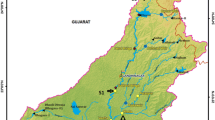Abstract
An attempt has been made to develop water quality index (WQI), using six water quality parameters Dissolved oxygen (DO), Biochemical oxygen Demand (BOD), Most Probable Number (MPN), Turbidity, Total Dissolved Solids (TDS) and pH measured at eight different stations along the river basin. Rating curves were drawn based on the tolerance limits of inland waters and health point of view. Bhargava WQI method and Harmonic Mean WQI method were used to find overall WQI along the stretch of the river basin. Five point rating scale was used to classify water quality in each of the study areas. It was found that the water quality of Netravathi varied from Excellent to Marginal range by Bhargava WQI method and Excellent to Poor range by Harmonic Mean WQI method. It was observed that the impact of human activity was severe on most of the parameters. The MPN values exceeded the tolerable limits at almost all the stations. It was observed that the main cause of deterioration in water quality was due to the lack of proper sanitation, unprotected river sites and high anthropogenic activities.
Similar content being viewed by others
References
APHA–AWWA–WPCF (1998). Standard methods for examination of water and waste water (2–9, 2–48, 4–87, 4–134, 5–3, 9–47), 20th Edition. New York: APHA.
Adarsh, S., Mahantesh, B. (2006). Personal Communication, Resident Doctors of Medicine, Hanagal Shree Kumareshwara Hospital, Bagalkot, Karnataka, India.
Bhargava, D. S. (1983). Use of a water quality index for river classification and zoning of the Ganga river. Environmental Pollution, B6, 51–67.
Bhargava, D. S., Saxena, B. S., & Dewakar (1998). A study of geopollutants in the Godavary river basin in India. Asian Environment, 36–59 (IOS press).
Bhujangaiah, N. S., & Vasudeva Nayak, P. (2005). Study of ground water quality in and around Shimoga city, Karnataka. Journal of Indian Council of Chemists, 22(1), 42–47.
Burden, F. R., Mc Kelvie, I., Forstner, U., & Guenther, A. (2002). Environmental Monitoring Handbook. Mc graw-Hill handbooks, New York, 3.1–3.21.
Chetana Suvarna, A., & Somashekar, R. K. (1997). Evaluation of water quality index of the river Cauvery and its tributaries. Current science (Current Science Association and Indian Academy of Science, Bangalore), 72(9), 640–646.
Cude, C. (2001). Oregon water quality index: A tool for evaluating water quality management effectiveness. Journal of the American Water Resources Ass, 37, 125–137.
De, A. K. (2003). Environmental chemistry (5th ed. 190, 215, 242–244) New Delhi: New Age International Publisher.
Deepa, V. J. (2004). A study of water quality and dissolved trace metal variations in river Godavari at Rajahmundury. M.Tech Thesis submitted to Dept. of Chemical Engineering, NITK, Surathkal, Deemed University, India, 4, 5, 8, 9, 15 18.
Dwivedi, S., Tiwari, I. C., & Bhargava, D. S. (1997). Water quality of the river Ganga at Varanasi. Institute of Engineers, Kolkota, 78, 1–4.
Gangadhara Bhat, H. (1992). Geology, Geomorphology and Littoral processes of a part of Dakshina Kannada coast through remoting sensing – A study. Ph.D. Thesis submitted to Mangalore University, India, 6–10, 77–80.
ISI (1991). Indian Standard Institute. Drinking Water Specifications. New Delhi, India.
Jayaprakash, R. I. (1988). A study of the environmental biology of Netravathi river system. A Ph.D. Thesis submitted to Mangalore University, 1–7, 9–14, 16–20, 25–27, 30–32, 106–107,113–114.
Leo, M. L., & Dekkar, M. (2000). Hand book of water analysis (1–25,115–117, 143, 175, 223–226, 261, 273, 767). New York: Marcel Dekker.
Madhyastha, M. N., Rekha, P. D., & Shashikumar, K. C. (1999). Impact of anthropogenic activitieson the river water quality along pilgrimage centres at Dakshina Kannada. Journal of Human Ecology, 10(1), 29–34 (Kamla–Raj Enterprises Publishers).
Pandey, M., & Sundaram, S. M. (2002). Trend of water quality of river Ganga at Varanasi using WQI approach. International Journal of Ecology and Environmental Science (28, 139–142). New Delhi: International Scientific Publications.
Ram, R. S., & Anandh, H. (1996). Water quality index of some Indian rivers. Indian Journal of Environmental Health, NEERI, Nagpur, 38(1), 21–34.
Sawyer, C. N., Mc Carthy, P. L., & Parkin, G. F. (1994). Chemistry for environmental engineering (4th ed., pp. 365–577). New York: Mc Graw–Hill International Edition.
Author information
Authors and Affiliations
Corresponding author
Rights and permissions
About this article
Cite this article
Avvannavar, S.M., Shrihari, S. Evaluation of water quality index for drinking purposes for river Netravathi, Mangalore, South India. Environ Monit Assess 143, 279–290 (2008). https://doi.org/10.1007/s10661-007-9977-7
Received:
Accepted:
Published:
Issue Date:
DOI: https://doi.org/10.1007/s10661-007-9977-7




